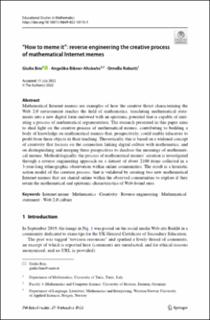| dc.contributor.author | Bini, Giulia | |
| dc.contributor.author | Bikner-Ahsbahs, Angelika | |
| dc.contributor.author | Robutti, Ornella | |
| dc.date.accessioned | 2023-03-01T15:20:39Z | |
| dc.date.available | 2023-03-01T15:20:39Z | |
| dc.date.created | 2022-10-19T08:50:31Z | |
| dc.date.issued | 2022 | |
| dc.identifier.citation | Educational Studies in Mathematics. 2022, 112:141–174. | en_US |
| dc.identifier.issn | 0013-1954 | |
| dc.identifier.uri | https://hdl.handle.net/11250/3055100 | |
| dc.description.abstract | Mathematical Internet memes are examples of how the creative thrust characterising the Web 2.0 environment reaches the field of mathematics, translating mathematical statements into a new digital form endowed with an epistemic potential that is capable of initiating a process of mathematical argumentation. The research presented in this paper aims to shed light on the creative process of mathematical memes, contributing to building a body of knowledge on mathematical memes that, prospectively, could enable educators to profit from these objects in their teaching. Theoretically, this is based on a widened concept of creativity that focuses on the connection linking digital culture with mathematics, and on distinguishing and merging three perspectives to disclose the meanings of mathematical memes. Methodologically, the process of mathematical memes’ creation is investigated through a reverse engineering approach on a dataset of about 2100 items collected in a 3-year-long ethnographic observation within online communities. The result is a heuristic action model of the creation process, that is validated by creating two new mathematical Internet memes that are shared online within the observed communities to explore if they retain the mathematical and epistemic characteristics of Web-found ones. | en_US |
| dc.language.iso | eng | en_US |
| dc.publisher | Springer | en_US |
| dc.rights | Navngivelse 4.0 Internasjonal | * |
| dc.rights.uri | http://creativecommons.org/licenses/by/4.0/deed.no | * |
| dc.title | “How to meme it”: reverse engineering the creative process of mathematical Internet memes | en_US |
| dc.type | Peer reviewed | en_US |
| dc.type | Journal article | en_US |
| dc.description.version | publishedVersion | en_US |
| dc.rights.holder | © The Author(s) 2022 | en_US |
| dc.source.pagenumber | 141–174 | en_US |
| dc.source.volume | 112 | en_US |
| dc.source.journal | Educational Studies in Mathematics | en_US |
| dc.identifier.doi | 10.1007/s10649-022-10173-1 | |
| dc.identifier.cristin | 2062579 | |
| cristin.ispublished | true | |
| cristin.fulltext | original | |
| cristin.qualitycode | 2 | |

